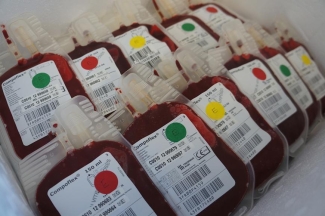Searching for safer red blood cell bags for pediatric recipients
Wednesday, August 10, 2016 Dr. Geraldine Walsh
This post is based on a ResearchUnit originally gathered in April 2016. ResearchUnits summarize recent scientific publications. They are produced and distributed by Canadian Blood Services’ Centre for Innovation.
There are public health concerns around the use of DEHP in blood bags, particularly for pediatric patients. This study shows a less toxic compound called DINCH may be a viable alternative.
From bottles to plastic…
Over 50 years ago, plastic replaced glass as the container of choice for collection and storage of blood and blood products. This greatly improved the safety of blood for transfusion by reducing the risk of contamination and containers breaking.
Polyvinylchloride, better known as PVC, is the most popular plastic for blood bags because it is durable, strong and can resist temperature changes. However, PVC is inflexible and brittle. To make flexible bags suitable for blood storage, PVC must be combined with a chemical called a “plasticizer”, which softens the plastic.
The most widely used plasticizer in blood bags is called DEHP, or di-(2-ethylhexyl)phthalate, and is also found in toys, medical tubing, water bottles, rainwear and many other goods. Despite its extensive use, there are concerns about its toxicity.
There is no clear evidence that DEHP has harmful effects in humans following transfusion, but animal studies have shown that it may affect the development of the reproductive system, particularly in males.
Due to the possibility of harm, a Health Canada Expert Advisory Panel recently concluded that alternatives to DEHP-containing medical devices should be sought, especially when fetuses, newborns, infants and young children are concerned.
Seeking alternatives
To explore alternative plasticizers, our researchers compared the quality of red blood cells stored in bags specifically designed for pediatric patients plasticized either with DEHP or two known less toxic plasticizers called DINCH and BTHC.

This research was conducted in two Centre for Innovation labs. Dr. Katherine Serrano, a research associate led work done in Dr. Dana Devine's at the Centre for Blood Research at UBC. Dr. Beatriz Bicalho, a postdoctoral fellow led work in Dr. Jason Acker's Edmonton, Alta lab. The work was conducted in collaboration with Fresenius-Kabi Deutschland GmbH, Bad Homberg, Germany.
These were extensive studies, in which almost every tool in our arsenal of RBC quality assessment measures was applied. To tap into the expertise in both the Devine lab and the Acker lab, each study arm had two similarly prepared duplicate pediatric bags: one set of red cell concentrates in pediatric bags was shipped to Edmonton for testing and the other remained in Vancouver for testing. Each bag was sampled by withdrawing a volume of RBCs from the bag under sterile conditions using a syringe.
"By pooling and splitting the units into matched pairs we were confident that we could conduct the study in parallel at two locations hundreds of miles away from each other (Vancouver and Edmonton)," explains Dr. Serrano.

Measuring quality
Our scientists looked at a number of things when assessing the red cell quality. Residual white blood cell count, and bacterial growth and pH levels, which could indicate bacterial contamination, were among the quality measures tested. They also looked at:
Metabolism of the cells:
- Partial pressure of oxygen, partial pressure of carbon dioxide, and glucose and lactate levels. These were all measured from a single volume of RBCs on a machine called a “blood gas analyzer”. The data reveal the metabolic status of the RBCs – how well they are metabolizing – and is a measure of how the RBCs are doing and the overall health of the RBCs in their environment. Measuring these parameters is particularly important when assessing new bags , as bags may have different levels of gas permeability and this may affect blood gas levels and metabolism.
Red blood cell membranes:
- Potassium release by the RBCs. This is of particular importance as the bags studied are intended for use in pediatric populations for whom potassium levels must be especially considered (potassium overload could cause serious cardiac complications). Potassium release increases with time in storage and indicates the quality of the RBCs.
- Number and size of microparticles shed by the RBCs: Increased shedding of microparticles (little blebs of RBC membrane that contain proteins derived from the red blood cell) is seen with increased storage time and reflects the quality and integrity of RBCs. They can be measured by flow cytometry in which microparticles are stained to visualize the correct population, sized, and counted.
- Percentage hemolysis: This indicates the number of RBCs that have burst open, releasing hemoglobin; again, this increases with storage time and may be THE key indicator of RBC integrity and quality.
- Gross morphology: This is assessed using a microscope to determine how the RBCs look on the surface (e.g. keeping their discoid, smooth shape vs. rounding up, looking rougher and spikier which indicates issues with red blood cell quality).
- Deformability: Ability to deform in circulation and squeeze through smaller capillaries in the body is crucial to RBCs ability to deliver oxygen throughout the body. Therefore, their elasticity or ability to deform into an elongated shape is really important.
- Lipid analysis: The relative distributions of various types of lipids in the RBC membrane and microparticles was also measured to see if they differed from bag type to bag type.
Findings
"It was surprising to us, how big of an impact the plasticizer choice can have on red blood cell quality," says Dr. Serrano. "The study shows that good alternatives to DEHP do exist."
The study found that:
- Metabolism of the red blood cells WAS affected by the bag they were stored in.
- Metabolism was best maintained in DINCH bags, and worst in BTHC bags.
- Red blood cells in BTHC bags had more signs of damage.
- Arrangement of phospholipids, an important structural part of red blood cell membranes, was not different among the bags.
- Red blood cell membranes were less damaged and better preserved in DEHP and DINCH bags than in BTHC bags.
- Overall, red blood cells in DEHP and DINCH bags showed good quality, while red blood cells in BTHC bags stored poorly.
The use of DEHP in medical devices, toys and other goods is controversial, and there are moves in several jurisdictions, including the European Union, to ban its use. Unfortunately, no plasticizers are completely without potential health concerns.
Of the alternative plasticizers proposed so far for use in blood bags, DINCH has the lowest toxicity levels, making it an attractive option. These studies show that DINCH bags are effective at maintaining red blood cell quality during storage.
While more research is needed — for example, to understand how the plasticizers affect red blood cells stored in different storage solutions — these results support a potentially promising future for DEHP-free blood storage.

Further reading:
Research Unit Searching for safer red blood cell bags for pediatric recipients
[1] Serrano K, Levin E, Chen D, Hansen A, Turner TR, Kurach J, Reidel A, Boecker WF, Acker JP, Devine DV: An investigation of red blood cell concentrate quality during storage in paediatric-sized polyvinylchloride bags plasticized with alternatives to di-2-ethylhexyl phthalate (DEHP). Vox Sang 2016;110:227-235.
[2] Bicalho B, Serrano K, dos Santo Pereira A, Devine DV, Acker JP: Blood bag plasticizers influence red blood cell vesiculation rate without altering the lipid composition of the vesicles. Transfus Med Hemother 2016;43:19-26.
Canadian Blood Services – Driving world-class innovation
Through discovery, development and applied research, Canadian Blood Services drives world-class innovation in blood transfusion, cellular therapy and transplantation — bringing clarity and insight to an increasingly complex health-care future. Our dedicated research team and extended network of partners engage in exploratory and applied research to create new knowledge, inform and enhance best practices, contribute to the development of new services and technologies, and build capacity through training and collaboration.
The opinions reflected in this post are those of the author and do not necessarily reflect the opinions of Canadian Blood Services nor do they reflect the views of Health Canada or any other funding agency.
Related blog posts
Researchers show that some methods used in the manufacturing of red blood cell units may be less damaging to the cells, which could reduce adverse reactions in transfusion recipients. This work may impact the future of how blood is collected in North America and around the world.
